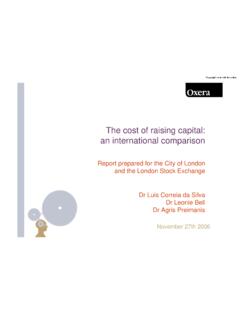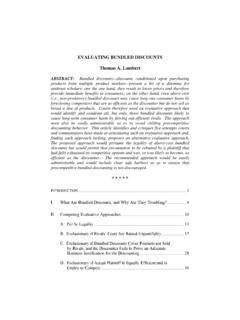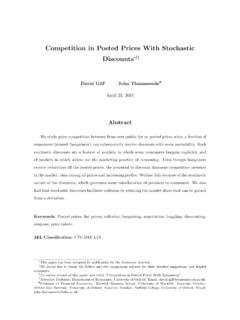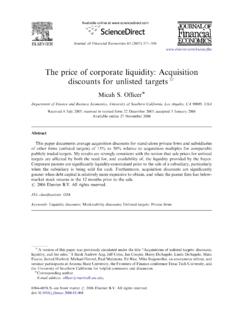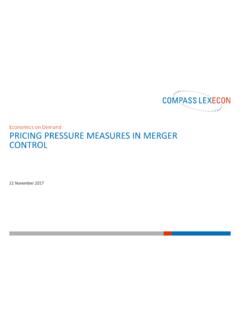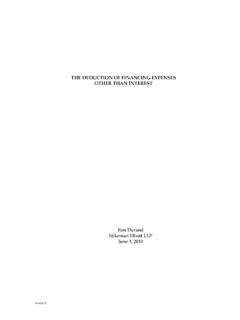Transcription of THE 340B DRUG DISCOUNT PROGRAM - ncpanet.org
1 THE 340B drug DISCOUNT PROGRAMWINTER 2013A Review and Analysis of the 340B ProgramiiA publication of the following organizations: the Biotechnology Industry Organization (BIO), the Community Oncology Alliance (COA), the National Community Pharmacists Association (NCPA), National Patient Advocate Foundation (NPAF), the Pharmaceutical Care Management Association (PCMA) and the Pharmaceutical Research and Manufacturers of America (PhRMA). Avalere Health performed supporting research and data analysis and compiled views expressed herein are those of the sponsoring 2013iiiExecutive Summary.
2 1I. Background on the 340B PROGRAM ..6A. The Genesis and Purpose of the 340B PROGRAM ..6B. General 340B Eligibility Criteria ..7C. Specific Criteria for 340B Hospital Eligibility ..7D. Ambiguous 340B Eligibility Requirements for Private Nonprofit Hospitals ..9E. The Uncertain Safety Net Status of Some 340B Hospitals ..10F. 340B Eligibility and Provision of Uncompensated Care ..10G. The Definition of Patient Under the 340B PROGRAM ..10H. Current Size and Recent Growth of the 340B PROGRAM ..11II. 340B PROGRAM May Distort Pharmacy and Hospital Markets ..15A. Potential Hospital Market Distortions.
3 15B. Potential Pharmacy Market Distortions ..16C. The Impact of 340B Incentives on Clinical Decision-Making ..17D. Potential cost -Shifting to Third-Party Payers Under 340B ..17 III. The Need for Oversight to Ensure 340B PROGRAM Is Consistent with Its Statutory Purpose ..18A. The Potential for drug Diversion ..18B. The Need for Continued Improvement in General PROGRAM Oversight ..19IV. The Role of the 340B PROGRAM After Coverage Expansion ..20V. Conclusion ..22 Appendix ..23 TABlE Of CONTENTS1 KEy fINDINGSE xecutive SummaryIn addition to making other important observations, this paper also raises questions about whether the 340B PROGRAM is leading to unintended and potentially harmful consequences for patients.
4 Areas of most concern include the following: Concerns that some uninsured indigent patients may not be experiencing direct benefit from the PROGRAM s existence. Anecdotal evidence that clinical decision-making may be skewed by efforts to take advantage of the 340B DISCOUNT . Growing evidence of displacement of non-340B providers who serve a key role in providing patient access to important health care services. The paper also identifies critical ambiguities in the 340B standards and potential deviations from Congressional intent that, along with limited oversight of the PROGRAM , have made it difficult to determine whether the PROGRAM is meeting Congressional goals.
5 In addition to identifying unintended and potentially harmful consequences for patients, the paper identifies several key findings to help policymakers ensure that the 340B PROGRAM meets its stated purpose helping uninsured indigent patients gain better access to prescription medicines. These key findings provide a roadmap for next steps: Adequate funding for the Health Resources and Services Administration (HRSA) is needed to ensure it is appropriately resourced to oversee the 340B PROGRAM in support of the efforts it has already begun. Continued oversight of the 340B PROGRAM is needed to ensure that the PROGRAM is consistent with its statutory purpose.
6 Improved transparency is necessary to help advance the PROGRAM s goals and ensure that resources are being directly used to reduce drug costs for uninsured indigent patients. Full and transparent accounting for all cost -savings derived from the 340B PROGRAM should be required to ensure that they are used to reduce drug costs for uninsured indigent patients. Clearer definition of the term patient is needed to ensure that it corresponds to the purpose of the 340B law, particularly given the increased coverage of prescription medicines by commercial insurance, coverage of uninsured persons through the Affordable Care Act and creation of Medicare Part D providing prescription drug insurance to seniors and disabled created the 340B PROGRAM in 1992 to help uninsured indigent patients gain better access to prescription medicines.
7 To achieve that goal, Congress created a PROGRAM that requires pharmaceutical manufacturers to provide discounts on outpatient prescription drugs to entities that serve high numbers of uninsured indigent patients. This PROGRAM , as originated, provided discounts to outpatient facilities for the purpose of sustaining certain services to this population. 340B is important today and going forward for the many patients who are dependent on this PROGRAM . This white paper examines the history and original intent of the PROGRAM as well as highlights key findings to help policymakers ensure that the 340B PROGRAM meets its stated purpose and to provide a roadmap for next steps to be considered.
8 Continued on next page2 KEy fINDINGSC ongress created the 340B PROGRAM in 1992 to help uninsured indigent patients gain better access to prescription drugs. To achieve that goal, Congress created a PROGRAM intended to reduce outpatient drug costs for certain types of health care facilities serving large numbers of uninsured indigent patients. Accordingly, the law requires phar-maceutical manufacturers to give statutorily specified discounts for drugs dispensed to outpatients of quali-fying entities, or Medicaid cannot cover the manu-facturer s Qualifying hospitals or clinics are known as 340B entities or covered entities.
9 The 340B law s legislative history makes clear that the intent of the 340B PROGRAM is to help uninsured indigent patients by giving covered entities that serve high num-bers of uninsured indigent patients access to discounts for outpatient Today, however, it is unclear whether this goal is being met, even as the PROGRAM continues to grow dramatically. Evidence suggests that the PROGRAM has departed significantly from its statu-tory foundation. There also is little concrete evidence of how and whether benefits of the 340B PROGRAM are reaching the intended beneficiaries of the PROGRAM namely uninsured indigent patients.
10 Moreover, in some instances, the 340B PROGRAM may skew patient care due to financial incentives that flow to the covered entities, but may not reach any measure, the PROGRAM has expanded significantly over the years. From 2005 to 2011, the number of hospitals participating in the 340B PROGRAM nearly tripled (growing from 591 to 1,673), and the number of hospital sites (separate locations of a given hospital that participate in 340B) nearly quadrupled (growing from 1,233 to 4,426).3 Today, about one-third of all hospitals participate in the 340B Overall, the number of covered entity sites that participate in the PROGRAM has nearly doubled in the past 10 years, from 8,605 in 2001 to 16,572 in An analysis performed by Avalere Health estimated that under the 340B PROGRAM , covered entities currently receive annual discounts of $2 billion on brand-name drugs Moreover, rapid 340B growth is projected to continue in future years.






